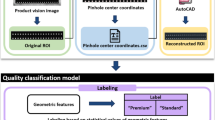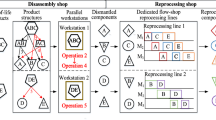Abstract
In this paper, a binary-extensible quality status encoding scheme, named IQSCT (IoT quality status code table), is proposed for the PCB-based product with available recovery options in remanufacturing. IQSCT is achieved by code evolution based on binary logic, in which the product flow and the quality information flow are integrated, and three key features of PCB-based product (PCB-module association, assembly-disassembly logic, and disassembly risk) are involved in production costing. With IQSCT, the manufacturer can have better decisions to reduce remanufacturing cost and improve resource utilization, which is verified by a case study based on the real data from BOM cost and corresponding estimation of Apple iPhone 11 series.
Similar content being viewed by others
References
Jia D, Li S. Optimal decisions and distribution channel choice of closed-loop supply chain when e-retailer offers online marketplace. Journal of Cleaner Production, 2020, 265: 121767
Walle A H. Remanufacturing marketing strategy and developing countries. Journal of Global Marketing, 1988, 1(4): 75–90
Chen W, Kucukyazici B, Verter V, Jesús Sáenz M. Supply chain design for unlocking the value of remanufacturing under uncertainty. European Journal of Operational Research, 2015, 247(3): 804–819
Branstetter L G, Drev M, Kwon N. Get with the program: software-driven innovation in traditional manufacturing. Management Science, 2019, 65(2): 541–558
Dweekat A J, Hwang G, Park J. A supply chain performance measurement approach using the internet of things: toward more practical SCPMS. Industrial Management & Data Systems, 2017, 117(2): 267–286
Zhang Y, Liu S, Liu Y, Yang H, Li M, Huisingh D, Wang L. The ‘Internet of Things’ enabled real-time scheduling for remanufacturing of automobile engines. Journal of Cleaner Production, 2018, 185: 562–575
Jeihoonian M, Zanjani M K, Gendreau M. Accelerating Benders decomposition for closed-loop supply chain network design: case of used durable products with different quality levels. European Journal of Operational Research, 2016, 251(3): 830–845
Jeihoonian M, Zanjani M K, Gendreau M. Closed-loop supply chain network design under uncertain quality status: case of durable products. International Journal of Production Economics, 2017, 183: 470–486
Subulan K, Taşan A S, Baykasoğlu A. A fuzzy goal programming model to strategic planning problem of a lead/acid battery closed-loop supply chain. Journal of Manufacturing Systems, 2015, 37: 243–264
Subulan K, Taşan A S, Baykasoğlu A. Designing an environmentally conscious tire closed-loop supply chain network with multiple recovery options using interactive fuzzy goal programming. Applied Mathematical Modelling, 2015, 39(9): 2661–2702
Fang C, Liu X, Pei J, Fan W, Pardalos P M. Optimal production planning in a hybrid manufacturing and recovering system based on the internet of things with closed loop supply chains. Operational Research, 2015, 16(3): 543–577
Govindan K, Jha P C, Garg K. Product recovery optimization in closed-loop supply chain to improve sustainability in manufacturing. International Journal of Production Research, 2015, 54(5): 1463–1486
Gu F, Ma B, Guo J, Summers P A, Hall P. Internet of things and Big Data as potential solutions to the problems in waste electrical and electronic equipment management: an exploratory study. Waste Management, 2017, 68: 434–448
Chen Y T, Chan F T S, Chung S H. An integrated closed-loop supply chain model with location allocation problem and product recycling decisions. International Journal of Production Research, 2014, 53(10): 3120–3140
Rowshannahad M, Absi N, Dauzère-Pérès S, Cassini B. Multi-item bilevel supply chain planning with multiple remanufacturing of reusable by-products. International Journal of Production Economics, 2018, 198: 25–37
Safaei A S, Roozbeh A, Paydar M M. A robust optimization model for the design of a cardboard closed-loop supply chain. Journal of Cleaner Production, 2017, 166: 1154–1168
Doolun I S, Ponnambalam S G, Subramanian N, Kanagaraj G. Data driven hybrid evolutionary analytical approach for multi objective location allocation decisions: automotive green supply chain empirical evidence. Computers & Operations Research, 2018, 98: 265–283
Shankar R, Bhattacharyya S, Choudhary A. A decision model for a strategic closed-loop supply chain to reclaim End-of-Life Vehicles. International Journal of Production Economics, 2018, 195: 273–286
Radhi M, Zhang G. Optimal configuration of remanufacturing supply network with return quality decision. International Journal of Production Research, 2015, 54(5): 1487–1502
Baptista S, Barbosa-Póvoa A P, Escudero L F, Gomes M I, Pizarro C. On risk management of a two-stage stochastic mixed 0–1 model for the closed-loop supply chain design problem. European Journal of Operational Research, 2019, 274(1): 91–107
Guiras Z, Turki S, Rezg N, Dolgui A. Optimization of two-level disassembly/remanufacturing/assembly system with an integrated maintenance strategy. Applied Sciences, 2018, 8(5): 666
Kazancoglu Y, Ozkan-Ozen Y D. Sustainable disassembly line balancing model based on triple bottom line. International Journal of Production Research, 2020, 58(14): 4246–4266
Masoudipour E, Amirian H, Sahraeian R. A novel closed-loop supply chain based on the quality of returned products. Journal of Cleaner Production, 2017, 151: 344–355
Niknejad A, Petrovic D. Optimisation of integrated reverse logistics networks with different product recovery routes. European Journal of Operational Research, 2014, 238(1): 143–154
Ondemir O, Gupta S M. Quality management in product recovery using the Internet of Things: an optimization approach. Computers in Industry, 2014, 65(3): 491–504
Al-Salem M, Diabat A, Dalalah D, Alrefaei M. A closed-loop supply chain management problem: reformulation and piecewise linearization. Journal of Manufacturing Systems, 2016, 40: 1–8
Yu H, Solvang W D. Incorporating flexible capacity in the planning of a multi-product multi-echelon sustainable reverse logistics network under uncertainty. Journal of Cleaner Production, 2018, 198: 285–303
Douzis K, Sotiriadis S, Petrakis E G M, Amza C. Modular and generic IoT management on the cloud. Future Generation Computer Systems, 2018, 78: 369–378
Büyüközkan G, Göcer F. Digital supply chain: literature review and a proposed framework for future research. Computers in Industry, 2018, 97: 157–177
Abdel-Basset M, Manogaran G, Mai M. Internet of Things (IoT) and its impact on supply chain: a framework for building smart, secure and efficient systems. Future Generation Computer Systems, 2018, 86: 614–628
Byun J, Woo S, Tolcha Y, Kim D. Oliot EPCIS: engineering a web information system complying with EPC Information Services standard towards the Internet of Things. Computers in Industry, 2018, 94: 82–97
Främling K, Maharjan M. Standardized communication between intelligent products for the IoT. International Federation of Automatic Control Proceedings Volumes. 2013, 46(7): 157–162
Liu Y, Han W, Zhang Y, Li L, Wang J, Zheng L. An Internet-of-Things solution for food safety and quality control: a pilot project in China. Journal of Industrial Information Integration, 2016, 3: 1–7
Kshetri N. 1 Blockchain’s roles in meeting key supply chain management objectives. International Journal of Information Management, 2018, 39: 80–89
Zhang Y, Han Y, Wen J. SMER: a secure method of exchanging resources in heterogeneous internet of things. Frontiers of Computer Science, 2019, 13(6): 1198–1209
Acknowledgements
The authors would like to thank the anonymous associate editor, and three referees for their constructive comments that helped improve the paper This research was supported by the National Natural Science Foundation of China (Grant Nos. 71871058 and 71531010).
Author information
Authors and Affiliations
Corresponding author
Additional information
Sijie Li received his PhD in 2006 from the Management School of USTC, China. He is an associate professor at Southeast University, China. His research interests include supply chain management, quality management and IoT.
You Shang is a PhD candidate in the School of Economics and Management at Southeast University, China. His research interests include remanufacturing optimization for mass production, and big data analysis therein.
Electronic Supplementary Material
Rights and permissions
About this article
Cite this article
Li, S., Shang, Y. A quality status encoding scheme for PCB-based products in IoT-enabled remanufacturing. Front. Comput. Sci. 15, 155615 (2021). https://doi.org/10.1007/s11704-020-9175-0
Received:
Accepted:
Published:
DOI: https://doi.org/10.1007/s11704-020-9175-0




